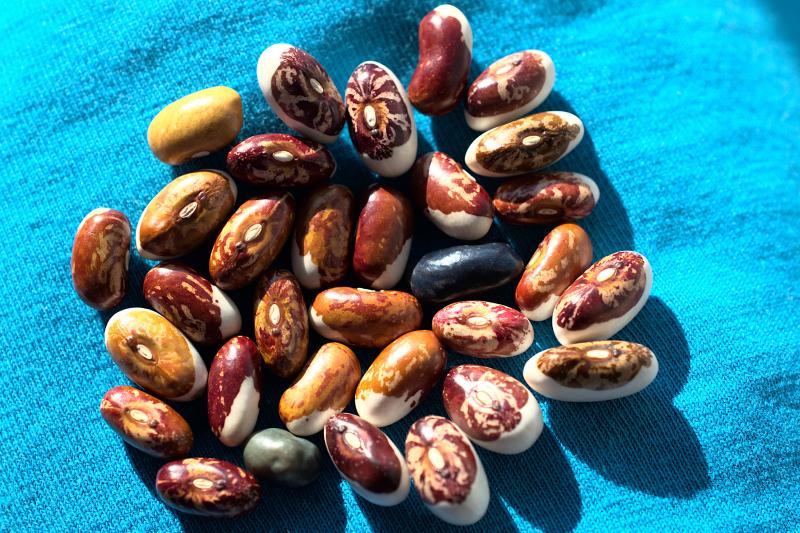Beans History
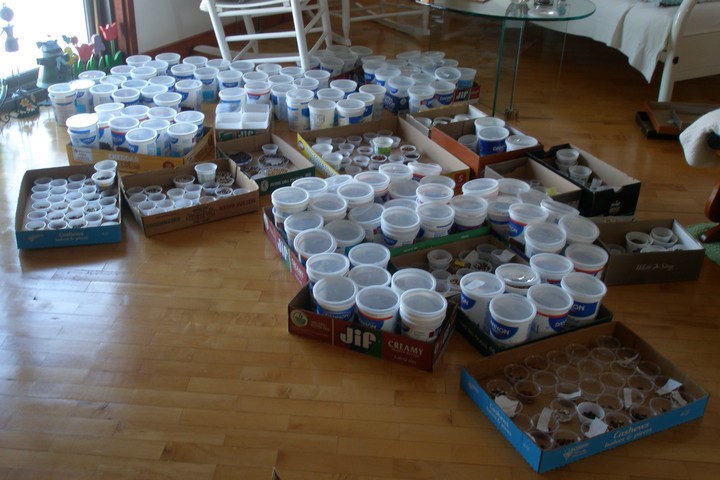 Winnowing Down the Collection
Winnowing Down the Collection
TABLE OF CONTENTS
- EDITORIAL NOTES
- SEASONS
- QUICK TIMELINE
- LITTLE EASY BEAN NETWORK
- ALPHABETICAL GROW LIST BY YEAR
- VARIETY NOTES
- THE OTHER BEAN PAGE
EDITORIAL NOTES:
This project page is not about general bean history - that topic is covered in other places on the internet. Instead this page is about my own history of growing beans and mostly about what I’ve been growing each year since about 2010.
As of this edit (December 12, 2022), I’m still reorganizing and rewriting this project page. You probably want the other bean page instead which is at: Anthive Beans as it doesn’t have as many lists and nitpicky details. Much of the information on this page is repeated on that page.
Detailed record keeping was not needed at first. I didn’t know I was going to be growing so many beans. Now with so many varieties and projects I need to consolidate my records into one location - this is it.
Part of what I am working on now is searching through old e-mail messages and other writings (garden journals from websites and usenet posts) to see what mentions of beans I’ve grown and also through messages about trades with other people - it is slow going for me and not likely to be done anytime soon but when I do get time and the energy for this sort of work any details will get added to this page.
You might find references to beans that I no longer grow. Why bother keeping track of them? Sometimes they’ve been inspirations or sources of possible outcrosses. Also as I am now winnowing down my collection it is also important to have some recollection of what I’ve seen and when that was.
Starting Out
To start out I picked up packets from the seed racks at the stores of Tendergreen green beans, Top Notch wax beans and Hendersons Bush Lima beans. That was the start.
SEASONS:
A more highly edited and amended version of what is on the other bean page (just in case someone shows up here first and is determined enough to read through all of this I do want to provide some context).
Early:
2010 the time I was growing wax beans, green beans, some soy beans for making soy milk and bush lima beans. The bush type green beans would sometimes grow a long climber so that was probably a reversion to a parental type or an outcross.
Then I started looking into how many varieties there were and wanted to grow some dry beans like the Pinto, Kidney and some bigger lima beans. A simple way to get more was to go to the store and buy a bag of bean soup mix. Then my list expanded from the initial three to sixteen which I planted in the North Garden (the same year I was getting rid of the horsetail and renovating along that edge for water flows so the garden was a mess to look at). Most did well, except the large lima beans, Lentils, Chick Peas and Blackeye Peas.
North Garden -
Aug 19 2011 (765K)
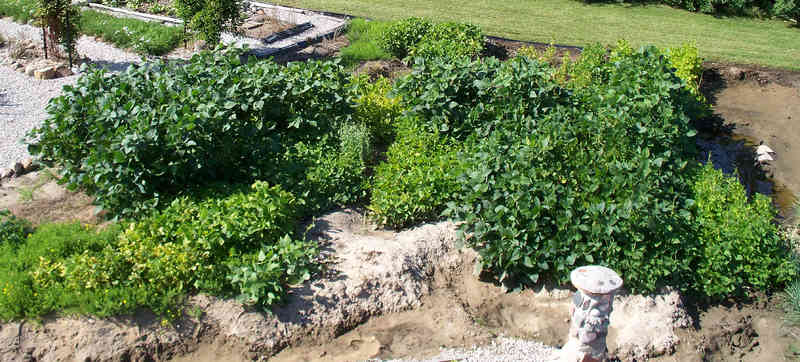
The harvest from that garden had some of the most beautiful things I had ever seen. Yes, I was hooked, completely.
Bean Mix Harvest -
Dec 1 2011 (2522K)
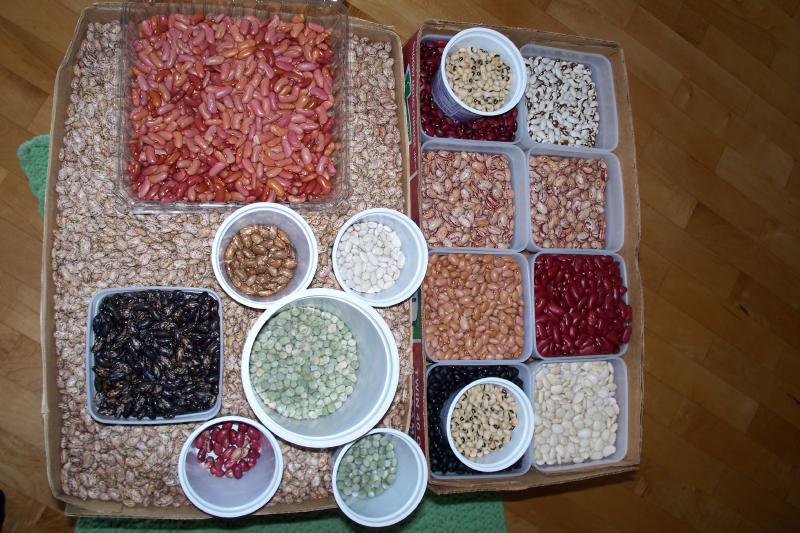
I also purchased or traded with a few people for more varieties increasing my bean collection to about 40 beans.
Middle:
With all of these varieties growing and being open-pollenated by bees (the small bumblebees are the most common bees seen in the beans) some crossbreeds started showing up. I no longer keep track of how many beans or crosses I have, but some of them I have replanted and gotten them stable enough to give names.
2016 was a year when I only planted a few varieties. Most of my garden space was taken up by squash and I knew I didn’t have enough room for much else.
The 2017 growing season started off fairly well with most beans sprouting that I planted. The only challenge was to get the Edamame Soybeans to survive sprouting stage. The chipmunks were eating them as fast as they sprouted - I only had three plants growing out of three hundred seeds planted. Some years nature gets a fair share earlier than I’d like. All together I planted over 50 varieties.
During and after planting I was trying to sort and combine containers to get the bean seed collection to take up less space - with few rainy days I’d not finished, but I took a picture to show a version of the madness… The bigger containers on the shelves were the beans I had enough to eat. Many of the smaller containers had collections of similar varieties which weren’t yet sorted out.
Sorting Beans -
Jul 4 2017 (1527K)
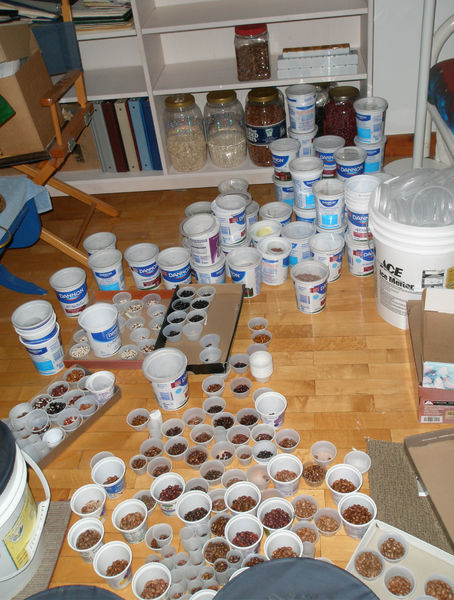
Some of the first dry beans of the 2017 season. The colors didn’t show up as well in this picture as I’d’ve liked.
First Beans -
Sep 7 2017 (1707K)
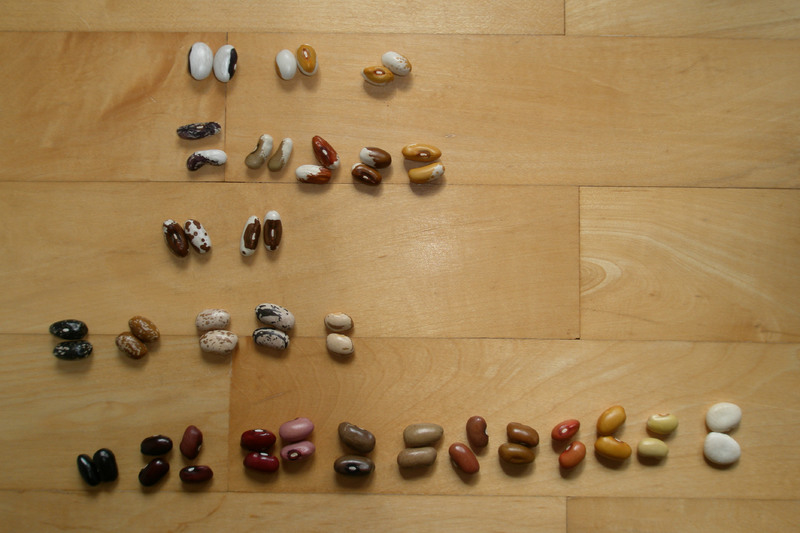
More Recent 2018+:
This bean had been around for several years and I finally grew it enough times that it was stable enough to get a name.
Sunset -
Jan 14 2018 (1272K)
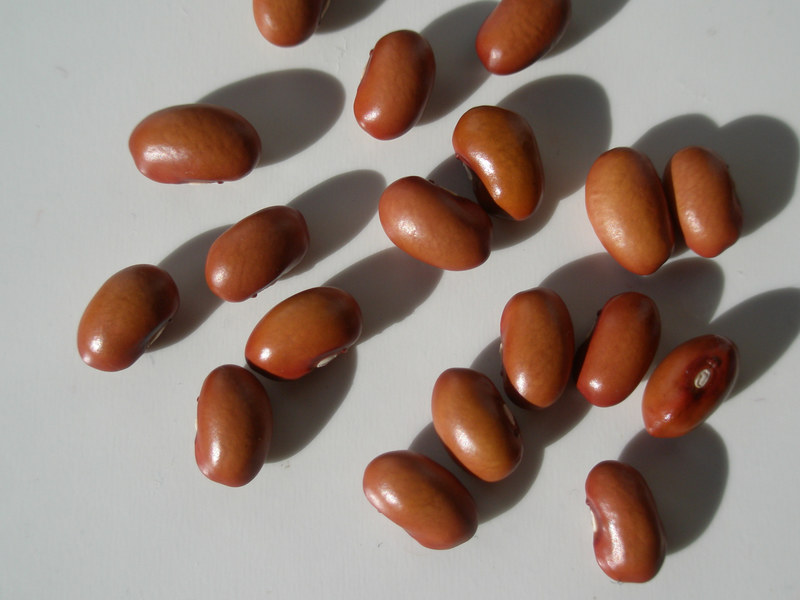
Yellow Hints -
Jan 14 2018 (1250K)
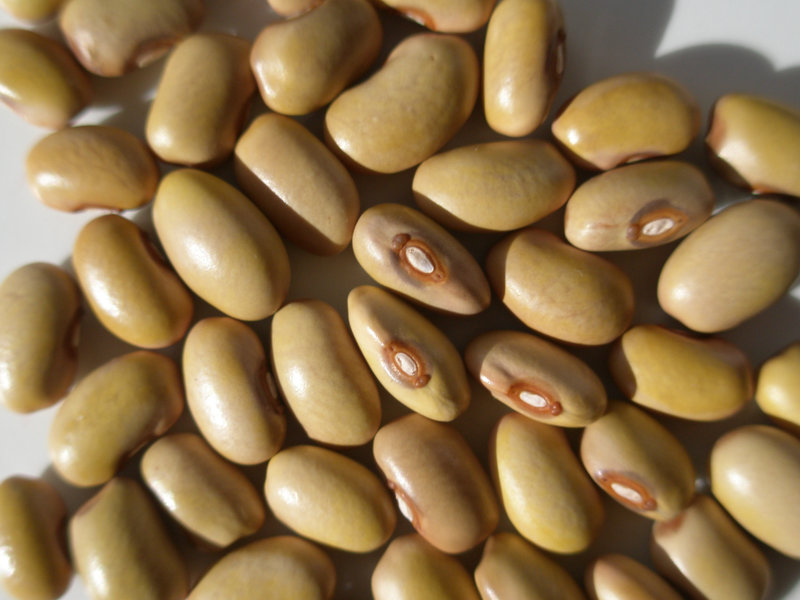
Sadly this was a bean that did not stablize.
Lavender -
Jan 14 2018 (1276K)
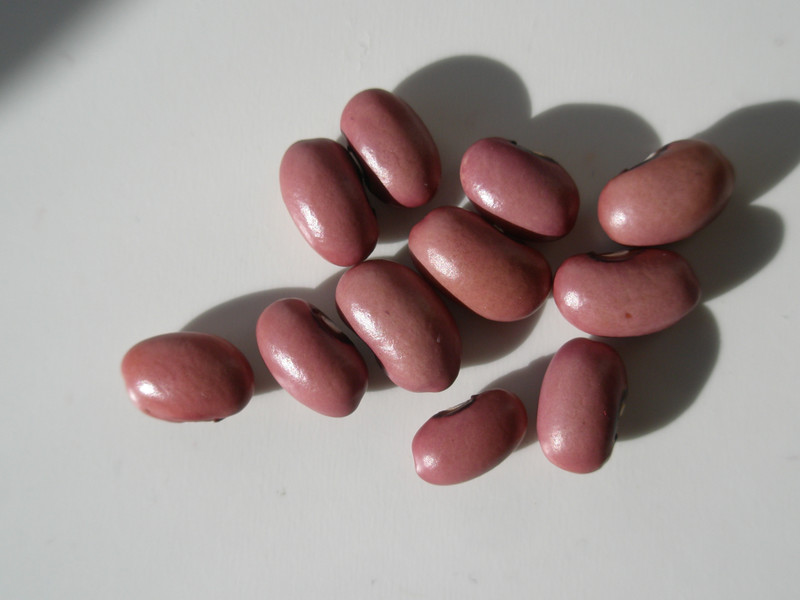
Light Olive -
Jan 14 2018 (1303K)
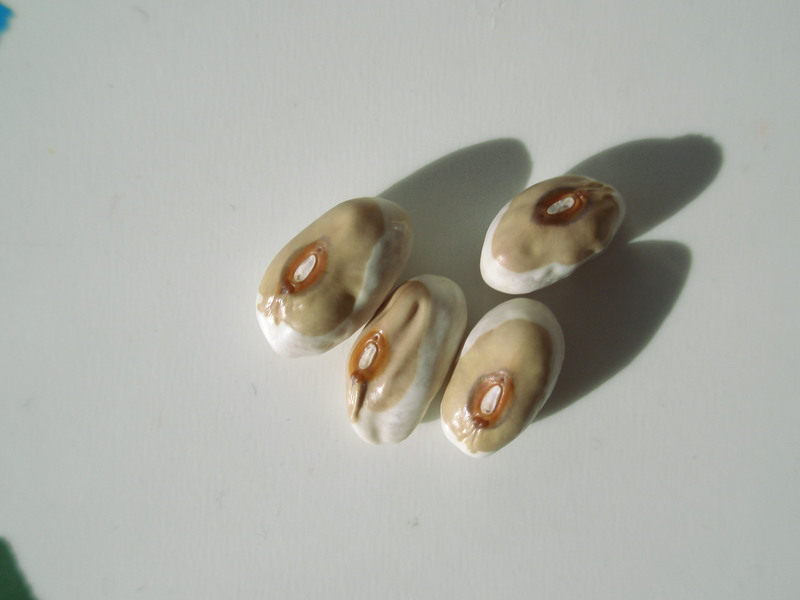
Red Purple White -
Jan 14 2018 (1263K)
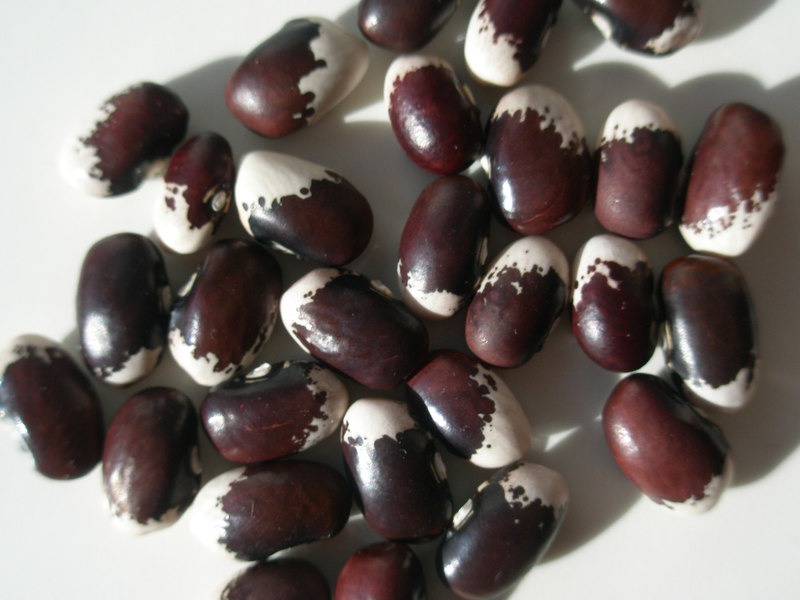
Four More Colors -
Jan 20 2018 (1381K)
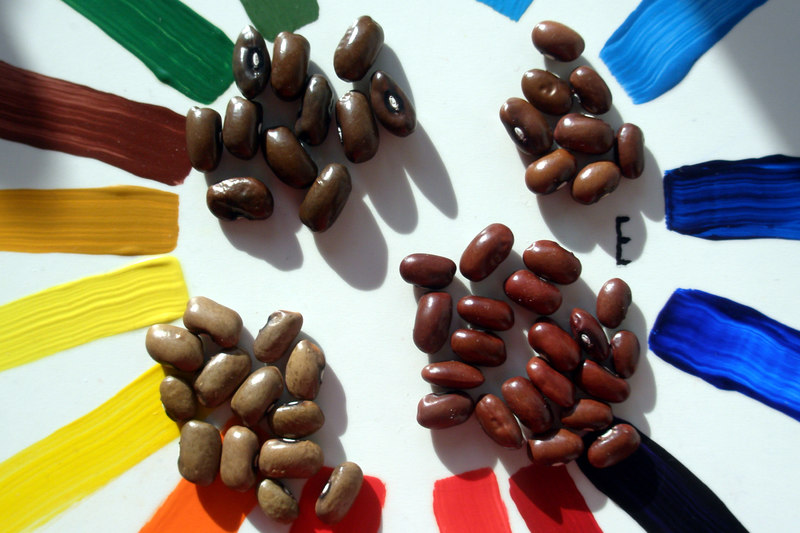
Multiple Layers -
Jan 20 2018 (1381K)
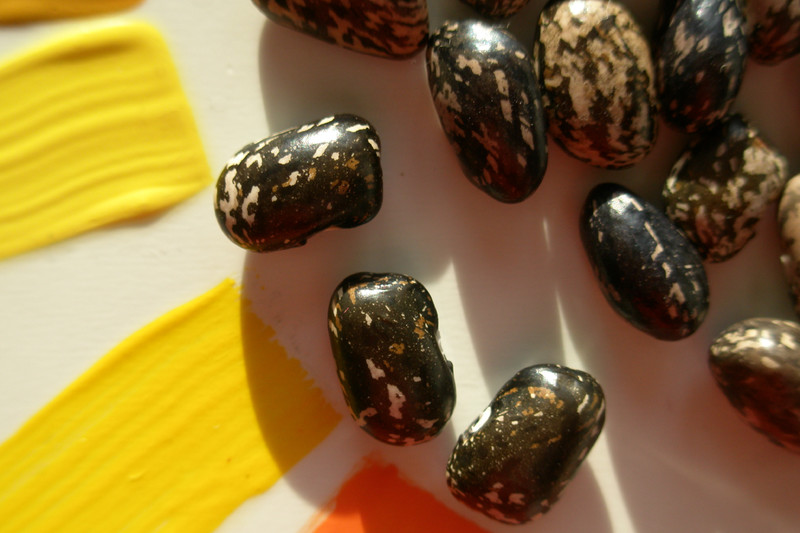
Still Sorting -
Jan 20 2018 (1460K)
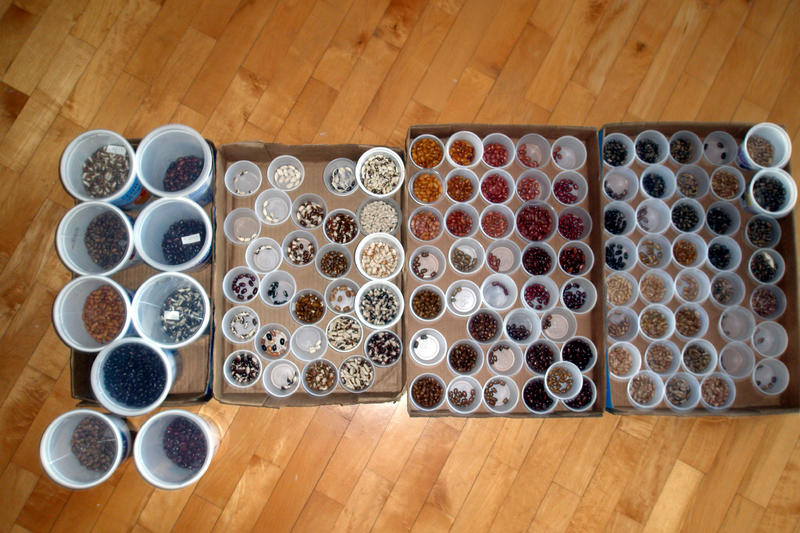
A new cross. Likely parents are the Tan Goats Eye beans I have grown for several years and either the Pink Tip or the various other derivations from the Yellow Eye beans (also known as Molasses Face). This bean made me so happy to see. Lemon Slice did become stable enough to keep the name and I do still grow it but it will not keep the light background unless put into cold storage (similar to how Cranberry or Horticultural beans will fade to more brown color in time).
Lemon Slice -
Nov 17 2018 (2569K)
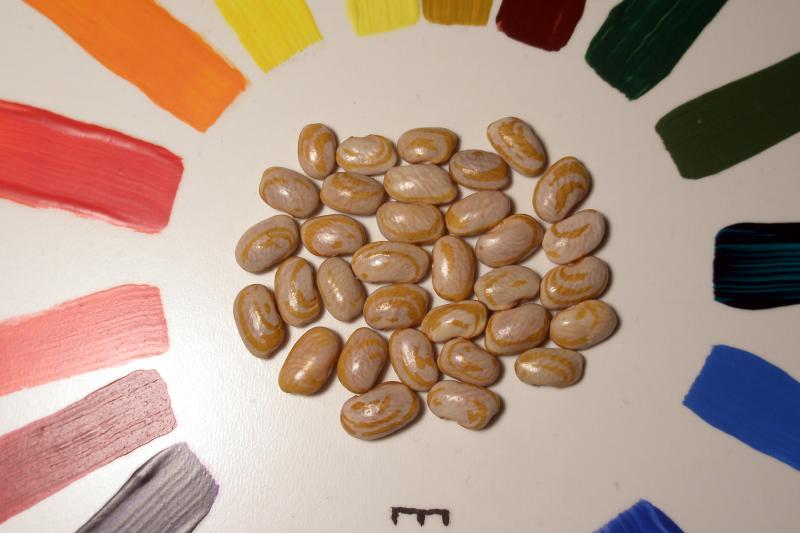
A selection of beans from what was grown the 2018 season showing how easy it is to shift the shape of a bean within a few years time by selecting what you are after from crosses that show up. These are likely from a cross between Money and Appaloosa beans.
Shape Change -
Nov 25 2018 (1324K)
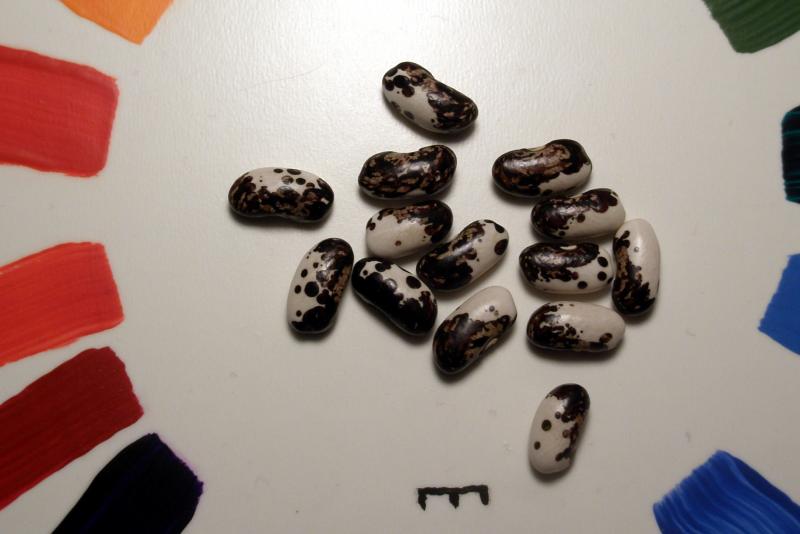
Eleven groups of four each from the half beans. I do not have the yellow ones in this picture so there are more I have grown in my collection. You may not be able to see it easily, but each group is a different color from the others.
Half White Beans -
Nov 25 2018 (1434K)
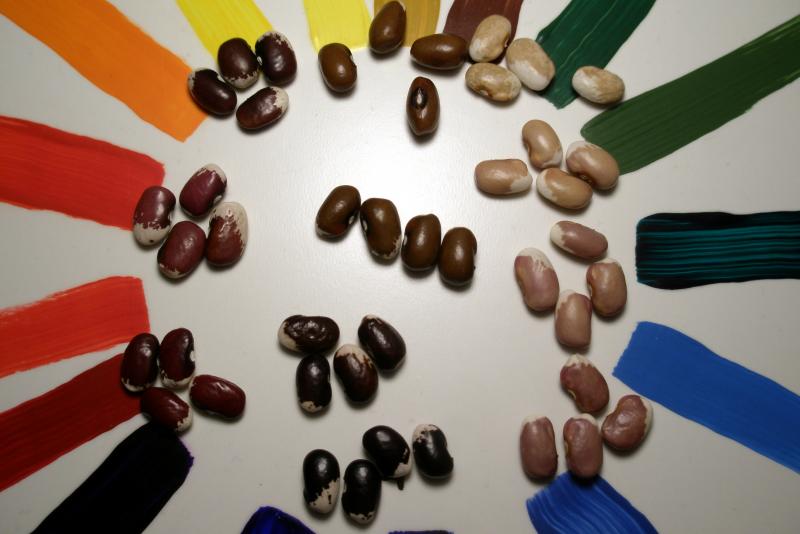
Another of the crosses that has shown up the past few years. I call it Yed because of the combination of yellow and red. What is so distinctive about these beans is the splotchy patterns they make.
Yellow Red Beans aka Yed -
Jan 17 2019 (1408K)
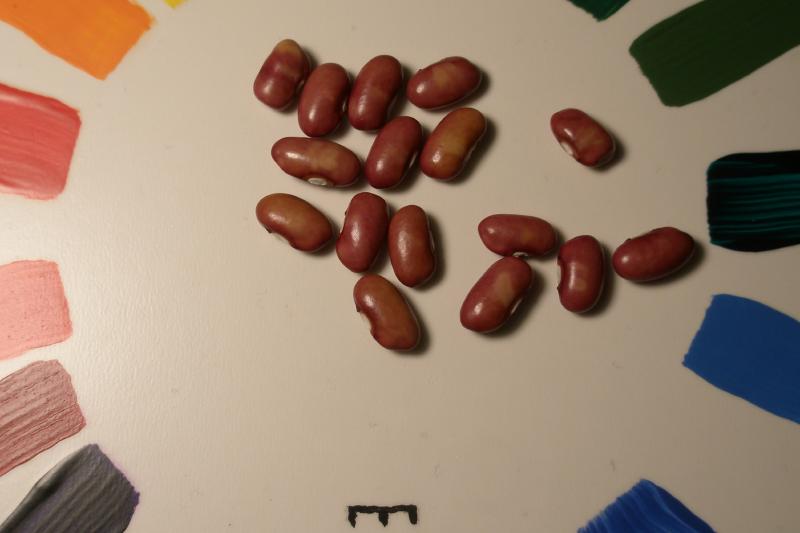
Getting ready to go to a seed swap - how to decide what to take?
Sorting Beans -
Feb 21 2019 (1394K)
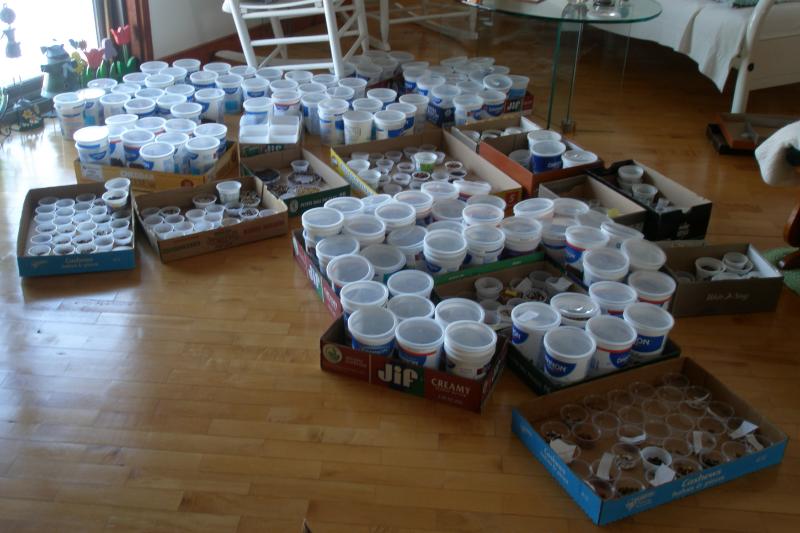
Finally finished up the sorting and winnowing of beans down to a more reasonable number of future samples. I still have way too many brown beans.
Sorting Beans Finished-
Apr 15 2019 (1493K)
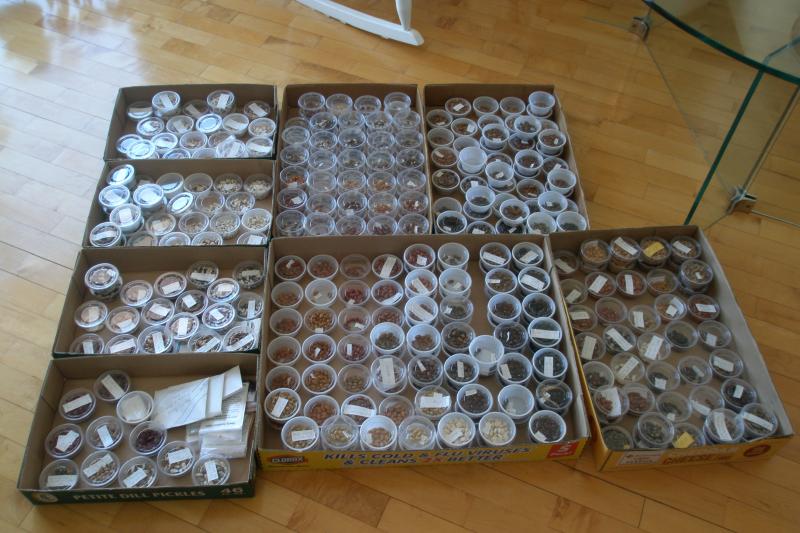
The 2020 season was pretty hot and dry the early summer. The beans were coming along but not doing as well as they would if we’d had a few more rains.
Some other bulk dry beans. Red Ryder, Hendersons Bush Lima and Huey.
Three Beans -
Nov 22 2020 (2838K)
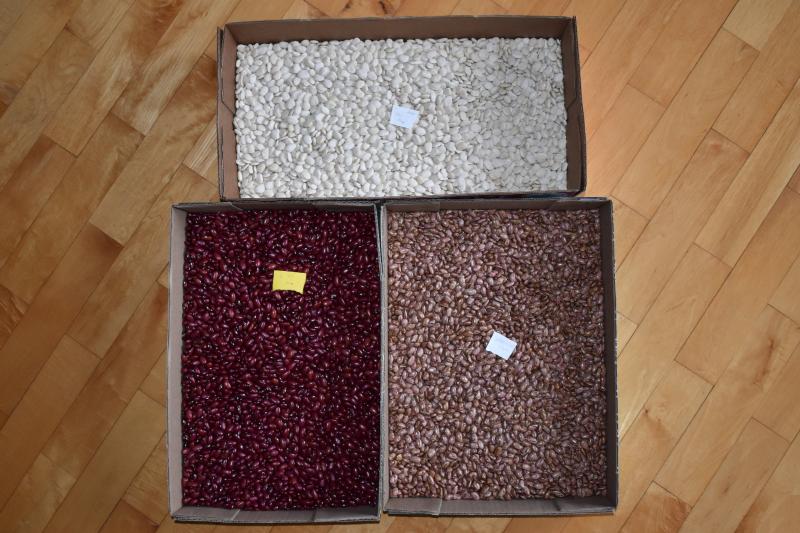
The beans in packages from the 2020 growing season, or at least most of them.
Mostly Sorted -
Jan 28 2021 (3352K)
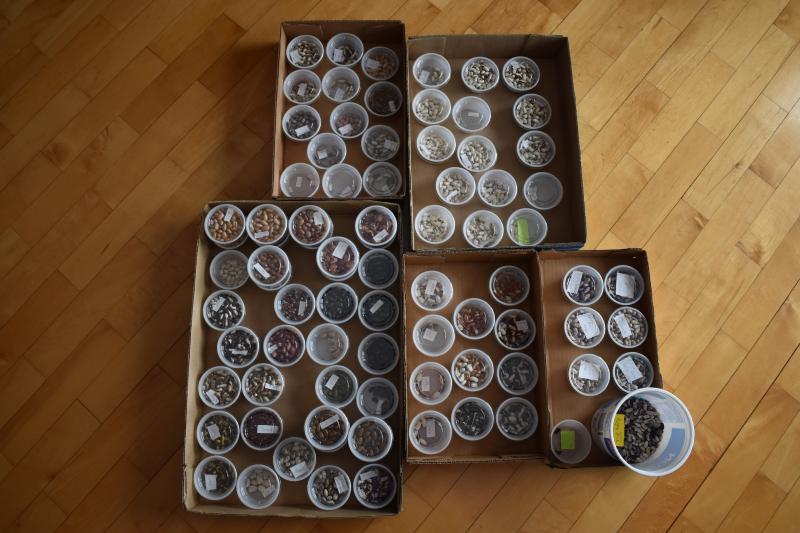
The earliest 2021 beans were up and growing with only a few failures in germination that I could tell. I thought the Fort Portal Jade were going to give up but they barely hung on through the whole summer. The neighboring Purple Dove beans were planted a week later and reached triple the size of the FPJs. You could barely see the FPJs behind the PDs, but they were there next to the peas.
Early Bean Planting -
Jun 23 2021 (4217K)
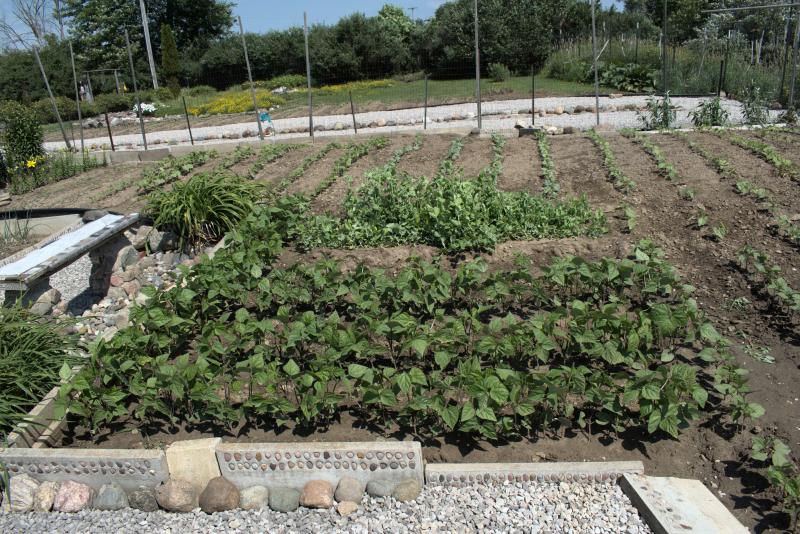
A mix of various colors of beans.
Fort Portal Jade beans grown in pots because they do not like it when I try to grow them outside in the gardens. I was down to my last four seeds and only two of them lived to flowering stage.
Fort Portal Jade -
Jul 29 2022 (4889K)
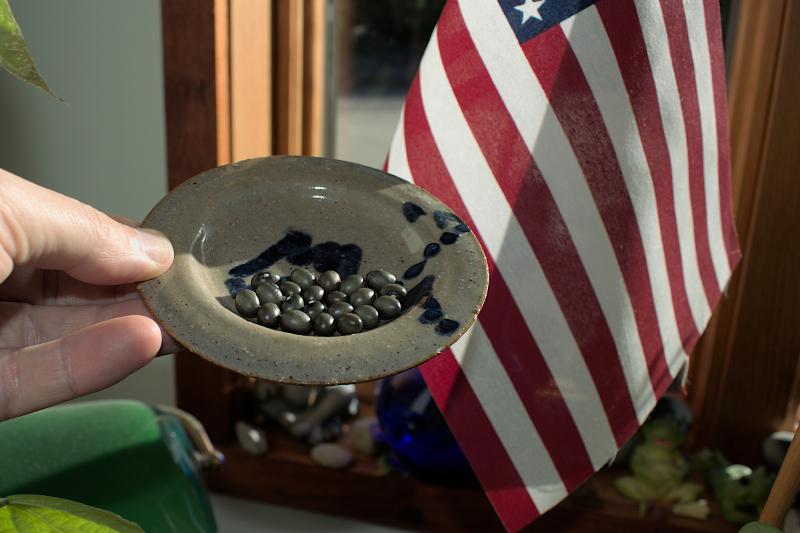
Some beans showing different colors even when grown on the same plant (these I’ve ended up naming Tinker’s Fire and there’s another picture down below).
Different Colors -
Aug 18 2022 (4858K)
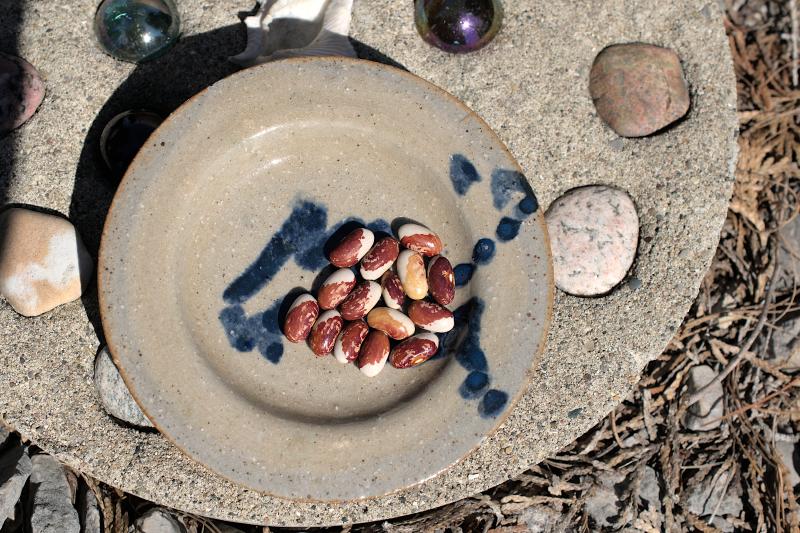
Sunrise in the sun, showing brighter pink shelly stage.
Sunrise -
Aug 29 2022 (3995K)
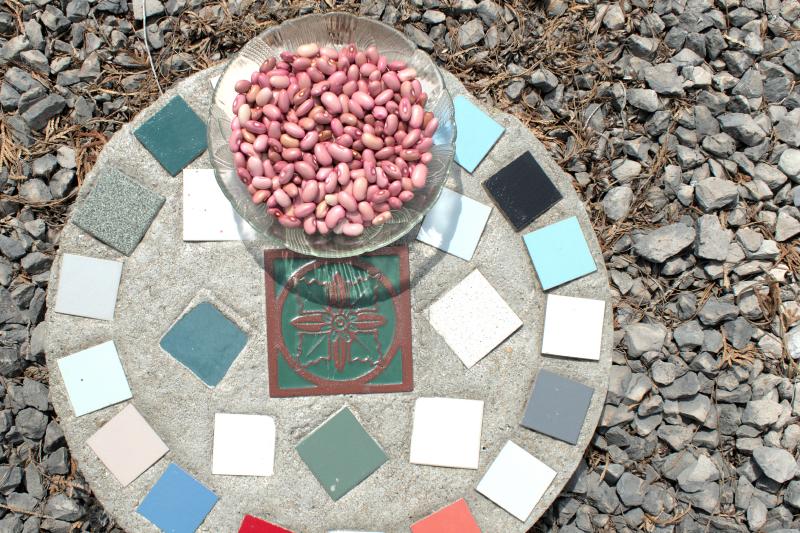
An interesting bean from some striped odd beans I’d planted to see what they’d do.
Gray and Pink -
Sep 3 2022 (3970K)
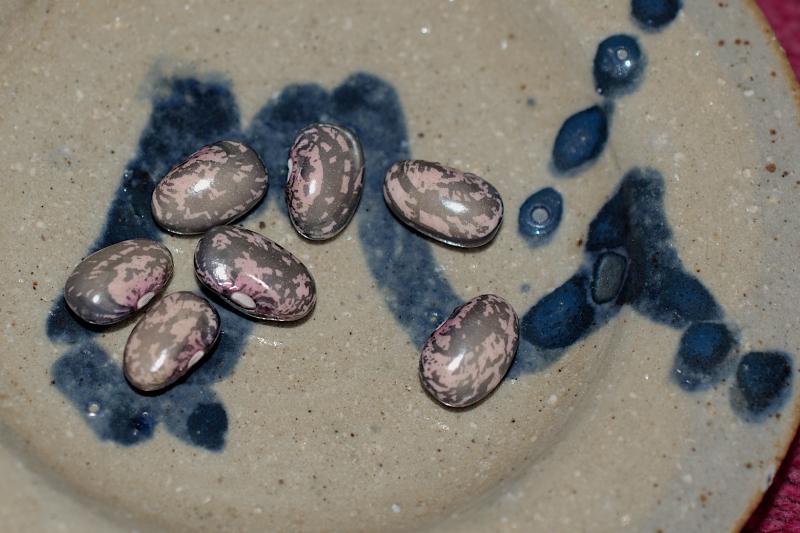
The above gray and pink bean after it has dried down and aged a little - now it looks to me more like a watermelon seed. Plus another pink bean that showed up as an off type to an olive colored bean - this one has aged enough to start showing more tan color than pink, so it doesn’t meet my hopes of it being a pink bean that actually stays pink as it ages.
Aged Pinks -
Nov 7 2022 (3925K)
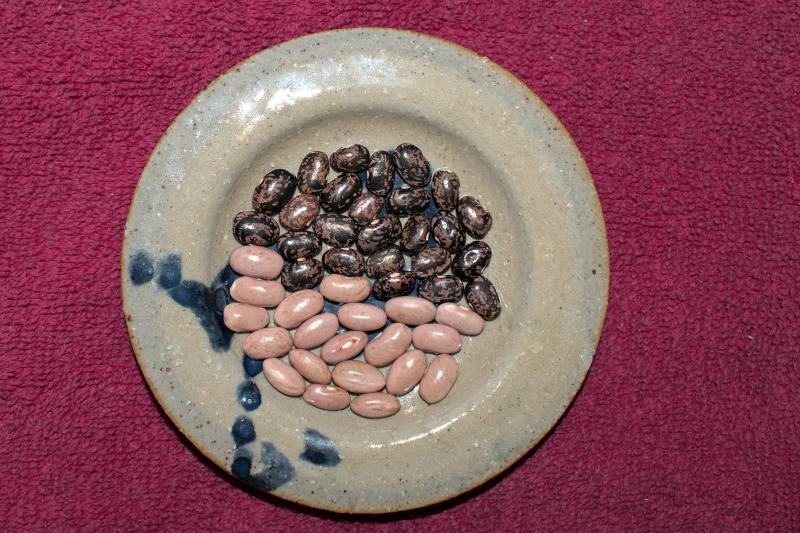
Two of the Purple Dove out crosses.
Purple Dove Odds -
Dec 10 2022 (4010K)
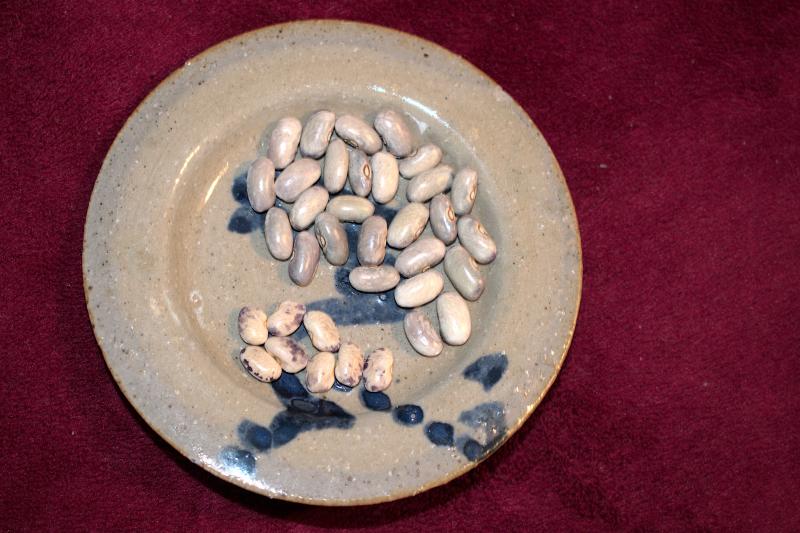
Three more Purple Dove out crosses.
Purple Dove Odds -
Dec 10 2022 (4062K)
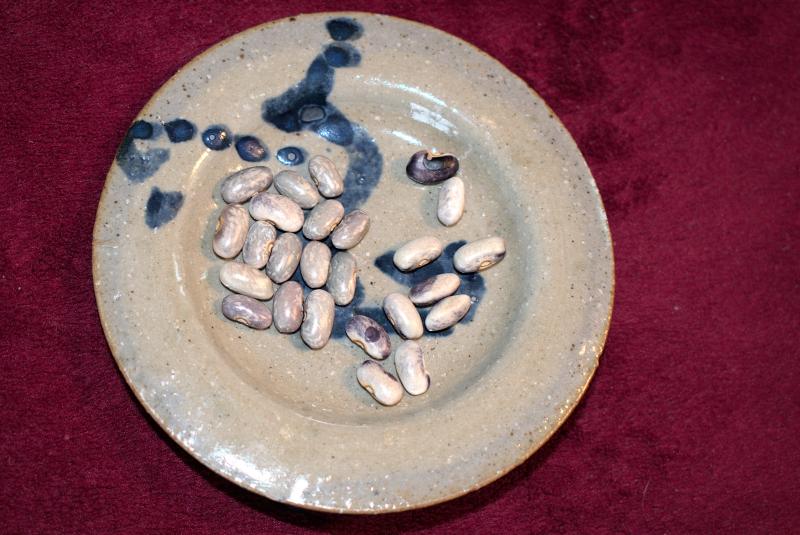
Tinker’s Fire, the name came to mind as the colors look like flames dancing and I thought of a travelling tinker sitting and watching a fire. I see in the picture there’s at least one cutshort that I will not replant.
Tinker’s Fire Beans -
Dec 12 2022 (4008K)
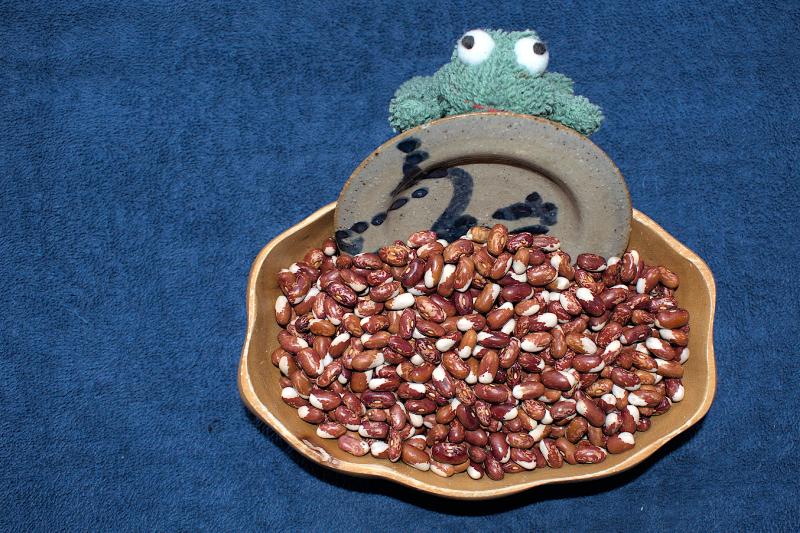
QUICK TIMELINE:
-
2010 Store seed racks: Tendergreen, Top Notch and Hendersons Bush Lima.
-
2010 Gleaned from farm field: Soy.
-
2011 Bean Mix Soup Blend store: Black Eye Peas, Chick Peas, Cranberry, Dark Red Kidney, Great Northern, Green Soup Peas, Lentils, Light Red Kidney, Pink, Small Red Kidney, and Turtle.
-
2011 Health Food Store: Soy a blend of mixed varieties, organic.
-
2012 Vermont Bean Company: Appaloosa, Black Turtle, Calypso, Coco, Etna, Besweet Soy (edamame), Money, Painted Pony, Peregion, Red Ryder, and Yin Yang. Along with the order came a packet of experimental green and wax beans which were good to eat but did not usually give seeds in return.
-
2012-20??(various dates) Trades with people: Aunt Sally Cornfield, Black Turtle, Commodore, Greasy, Jumbo, Pink Tip, Pinto, Dark Red Kidney, Yellow Eye (two trades). Also some cowpeas (which I did not grow).
-
???? Yellow Eye aka Molasses Face from the Health Food Store, organic.
-
201? Store seed racks: Cherokee Wax.
-
2018, 2019 Seed Swaps: Anasazi, Cha Kura Kake Soy (edamame), Fortex, Kahnawake Mohawk Pole, Nona Agnes, Purple Pole, Sacre Blue, Sieva Lima, Takara Early Adzuki, True Red Cranberry.
-
2014 - 2020 Greenhouse: Anasazi, Scarlet Runner and Kermit Smokey Mountain.
-
2018 - present Little Easy Bean Network: A whole bunch (see the next chapter).
-
2020 Other Trades: Galopka (did not like our conditions).
-
2021 Chinese Food Store: Adzuki beans (larger than Takara Early).
LITTLE EASY BEAN NETWORK:
These are requests and bonus beans combined so not all may have been returned.
First try is when I first grew them, if they completely failed I put that down. Another try is a continued attempt to grow the bean so it can be returned. Increased is a previously grown bean that isn’t quite bulk bean production yet but I’m trying to build up my seed stock so I can make a larger planting. Bulk bean production is a larger planting to see how they do. If you don’t see them grown again that means I’ve decided to not grow them as often any more due to limitations of space and time I can only grow so many and I have to try to be productive enough too since we do want to eat some of them.
2018 Little Easy Bean Network
First try : Burgundy Kidney, Dapple Gray, Early Warwick, Fort Portal Jade, Meravigllia de Veneza, Montezuma Red, Munachedda Pale, Old Black Coco, Pink Early, Pinto, Purple Dove, Red Bollito, Red Lima, Swedish Brown, Yellow Long.
2019 Little Easy Bean Network
First try : Adams Family 6 Weeks, Blaugraue, Bomba, Conserva, Fisher, Flossie Powell Lima, Green Savage, Hidatsa Shield Figure, Improved Golden Wax, Ottis Stuart, Victoria Brown Eyes, White Refugee.
Another try : Early Warwick, Fort Portal Jade
Increased : Dapple Gray, Purple Dove.
2020 Little Easy Bean Network
First try : Brown Lima, Montville, Pisarecka Zlutoluske, Purple Diamond, Purple Rain, Purple Rose, Top Notch, Venda.
Another try : Early Warwick, Hidatsa Shield Figure
Bulk bean production : Dapple Gray, Purple Dove
2021 Little Easy Bean Network
First try : Lavender, Puregold Wax, Shelleasy x Soldier, Top Notch.
Another try : Fort Portal Jade, Hidatsa Shield Figure, Montville
Increased : Pisarecka Zlutoluske
Bulk bean production : Brown Lima, Dapple Gray, Purple Dove
2022 Little Easy Bean Network
First try: Atwater, Andikove, Baby Green Lima(failed), Blooming Prairie, Chaska Purple, Delano, Fukuryu Chunaga(failed), Koronis Three Islands, Purple Rose Creek, Striped Bunch, Viola
Another try : Montville, Shelleasy x Soldier
Increased : Conserva, Fort Portal Jade, Lavender, Venda
Bulk bean production : Purple Dove, Victoria Brown Eyes
2023 Little Easy Bean Network
First try: No new beans this year as I hoped to get some of the previous beans grown out so I could return them.
Another try : Andikove, Shelleasy x Soldier, Striped Bunch
Increased : Lavender
Bulk bean production : Purple Dove, Venda, Victoria Brown Eyes
2024
First try: Not known yet…
Another try : Andikove, Montville
Increased : ?
Bulk bean production : Purple Dove, Venda
ALPHABETICAL GROW LIST BY YEAR:
I am still working on my coding system.
Some abbreviations used for sources:
- (C) Commercially available
- (D) Greenhouse
- (H) Health food store
- (N) Little Easy Bean Network bean
- (O) Other source
- (P) Personal collection/selection
- (S) Seed swap
- (T) Trade
- (V) Vermont Bean Company
- (Z) Zeedman
2010
- Hendersons Bush Lima (C)
- Tendergreen Improved (C)
- Top Notch (C)
- Soy (O) Field variety, not grown again.
Early Outcrosses and Oddities
My first season growing the Tendergreen beans I had one outcross where it looked like a Pinto was involved - it was an easier bean to shell and lighter in color. I also had some white beans show up which were a semi-runner - the pods were still edible, white seeded beans - I only grew them one more year. I kept the easier shelling beans and grew them a few times but have not grown them often enough to keep them going. There were too many other more interesting beans to explore.
2011
- Black Eye Peas (C)
- Black Turtle (C)
- Chick Peas (C)
- Cranberry (C)
- Dark Red Kidney (C)
- Great Northern (C)
- Lentils (C)
- Light Red Kidney (C)
- Pink (C)
- Small Red Kidney (C)
- Soy (H) Blend of several varieties - organic.
Early 2012
In going back through old records I’m trying to find out exact mentions of sources and when I first obtained various beans. In some cases it has raised more questions than it has answered so I’ll put down my questions here too. This is primarily only for historical reasons as in most cases I no longer grow these any more anyways, but I do want a complete record as best I can provide just for my own memory if I later find out something which helps me resolve the questions.
From an e-mail sent to someone (ML) Jan 01 2012 talking about a seed exchange:
this is my current working list:
sources codes prefix key:
- general placeholder
* grocery store soup mix assume non-organic then grown by me
H health store non-organic source
h health store organic source
O health store non-organic source, then grown by me
o health store organic source, then grown by me
C seed company non-organic
c seed company organic
S seed company non-organic then grown by me
s seed company organic then grown by me
U unknown assume non-organic source
u unknown assume non-organic source then grown by me
- adzuki
h red
* black beans (turtle beans)
* blackeyed peas
* cranberry beans (borlotti)
- green
C tendergreen improved bush
- kidney beans
* light red
* dark red
- lima
C henderson bush
- peas
S alaska early
C dwarf gray sugar stringless
S little marvel
c oregon sugar pod II
* split pea (green soup peas with white flowers and plenty of tendrils)
S mix of alaska early and little marvel
* pink beans (chili beans)
* pinto beans
* red beans
- soy beans (non-glyphosate resistant)
o mixed varieties without dark nubs
o mixed varieties with dark nubs
- wax beans
S top notch golden bush
H yellow eyed beans
A Bit Later 2012
Beans ordered from Vermont Bean Company
- Appaloosa (V)
- Besweet Soy (edamame) (V)
- Black Turtle (V)
- Calypso (V)
- Coco (V)
- Etna (V)
- Experimental Green (V)
- Experimental Wax (V)
- Money (V)
- Painted Pony (V)
- Peregion (V)
- Red Ryder (V)
- Yin Yang (V)
From what I can remember and find in searching records I grew almost all of the above beans in 2012. The ones I did not grow were any that I had newer replacements from the Vermont Bean Company so I did not grow my previously acquired Black Turtle, Borlotti, Red, Light Red Kidney and Dark Red Kidney and I also did not grow Calypso or the Black Eyed Peas.
Traded with ML to obtain Improved Commodore sourced from American Seed Co in 2008, three others were also from ML who got them from “a lady in Wisconsin” in 2008: Black Turtle Beans, Kidney (Dark Red), Pinto beans. All of these were pretty generic beans of their type.
Interim Note
Most of what I grew for the next few years were mixes of the above. I was often working on selections from Peregion (which I consider a blend). Eventually I would get several good crosses from Peregion to work with more (Reddish Pere in my early records eventually ended up being called Huey).
2013
2014
- Scarlet Runner (D)
When did I get Greasy, Jumbo, Yellow Eye, Pink Tip?
2015
2016
2017
- Appaloosa (V)
- Greasy (T)
- Hendersons Bush Lima (C)
- Painted Pony (V)
- Pinto (T)
- Red Ryder (V)
- Scarlet Runner (D)
- Sunset (P)
- Top Notch (C)
- Yed (P)
- Yellow Eye (HT)
2018
- Appaloosa (bush, dry) (V)
- Blue Pod (semi, dry) (P) (SMR-20??-BP)
- Burgundy Kidney (bush, dry) (N)
- Dapple Grey (bush, dry) (N)
- Dark Accent (semi?, dry?) (P) (SMR-20??-DA)
- Early Warwick (bush, dry) (N)
- Etna (bush, dry) (V)
- Fort Portal Jade (semi, dry) (N)
- Goats Eye Pinto (semi?, dry?) (P) (SMR-20??-GEP)
- Half Brown (semi?,dry?,early?) (P) (SMR-20??-HB)
- Half Dark (semi?,dry?,early?) (P) (SMR-20??-HD)
- Half Light (semi?,dry?,early?) (P) (SMR-20??-HL)
- Half Pinto (early?, bush?) (P) (SMR-20??-HP)
- Hendersons Bush Lima (bush) (C)
- Kermit’s Smokey Mountain (pole) (D)
- Large Olive (early?) (P) (SMR-20??-LO)
- Lavender (early?) (P) (SMR-20??-L)
- Mattie Greene (bush) (T)
- Meravigllia de Veneza (pole wax) (N)
- Montezuma Red (semi, dry) (N)
- Munachedda Pale (pole, dry) (N)
- Mystery Bean ()
- Odd Pinto (semi?, dry?) (P) (SMR-20??-OP)
- Old Black Coco (semi, dry) (N)
- Olive (early?) (P) (SMR-20??-O)
- Olive Eye (early?, bush?) (P) (SMR-20??-OE)
- Pink Early (semi, dry) (N)
- Pink Pinto (early?, bush?) (P) (SMR-20??-PP)
- Pink Pinto Long (early?, bush?) (P) (SMR-20??-PPL)
- Pinto (semi, dry) (N)
- Purple Dove (bush, dry) (N)
- Purple Eye (early?, bush?) (P) (SMR-20??-PE)
- Red Bollito (pole) (N)
- Red Goats Eye (early?) (P) (SMR-20??-RG)
- Red Lima (pole) (N)
- Red Ryder (semi, dry) (V) (SMR-20??-RR)
- Speckeled Stripe Mix (semi?, dry?) (P) (SMR-20??-SSM)
- Speckled Dark (early?, bush?) (P) (SMR-20??-SD)
- Spotted Brown (early?, bush?) (P) (SMR-20??-SB)
- Spotted Yellow Eye (semi, dry) (P) (SMR-20??-SYE)
- Steel Purple (early?) (P) (SMR-20??-SP)
- Stripe (early?, bush?) (P) (SMR-20??-ST)
- Sunset (early?) (P) (SMR-20??-S)
- Swedish Brown (bush, dry) (N)
- Tan Goats Eye Misfits (semi?, dry?) (P) (SMR-20??-TGEM)
- Top Notch (bush, wax) (C)
- Two Spot (early?, bush? wax?) (P) (SMR-20??-TS)
- Yed (early?, bush?) (P) (SMR-20??-YED)
- Yellow (early?) (P) (SMR-20??-Y)
- Yellow Eye 1 (semi?,dry?,early?) (P) (SMR-20??-YE-1)
- Yellow Eye 2 (semi?,dry?,early?) (P) (SMR-20??-YE-2)
- Yellow Eye 3 (semi?,dry?,early?) (P) (SMR-2017-YE-3)
- Yellow Eye 4 (semi?,dry?,early?) (P) (SMR-2017-YE-4)
- Yellow Eye (semi, dry) (O) (SMR-20??-YE)
- Yellow Long (pole, wax) (N)
- Yellow Soldier (bush?, wax?) (P) (SMR-20??-YS)
2019
- Adam’s Family 6 Weeks (pole, snap) (N)
- Anasazi (pole) (S)
- Blaugraue (pole, dry) (N)
- Bomba (bush, dry) (N)
- Conserva (bush, snap) (N)
- Cranberry (bush, dry, shellies) (C)
- Cranberry Spritz (?) (P)
- Dapple Grey (bush, dry) (N)
- Dark Beans from mix (bush, snap) (T)
- Dominoes (?) (P)
- Early Warwick (bush, dry) (N)
- Fisher (bush, dry) (N)
- Flossie Powell Lima (pole) (N)
- Fortex (pole) (S)
- Fort Portal Jade (semi, dry) (N)
- Golden Spot (bush?, dry?) (P)
- Green Savage (pole, snap) (N)
- Grey Pink Pinto (bush?, dry?) (P)
- Hendersons Bush Lima (bush) (C)
- Hidatsa Shield Figure (semi, dry) (N)
- Huey (previously called Reddish Pere) (bush, dry) (P)
- Improved Golden Wax (bush, wax) (N)
- Kahnawake Mohawk Pole (pole) (S)
- Lemon Slice (?) (P)
- Monk’s Beard (pole) (S)
- Monster (bush?, dry?) (P)
- Orange Spotted Yellow Eye (bush?, dry?) (P)
- Ottis Stuart (pole, snap) (N)
- Pale Big from mix (bush, snap) (T)
- Purple Dove (bush, snap, dry) (N)
- Purple Pod (pole, dry) (S)
- Red Lima (pole) (N)
- Small Light Yellow Eye (bush?, dry?) (P)
- Solid Long Red, Brown, Tan from mix (bush, snap) (T)
- Spotted Half (brown red black) (semi?,dry?,early?) (P)
- Spotted One Line (bush?, wax?) (P)
- Spotted Tan/Brown (?) (P)
- Sunset (bush?, dry?) (P)
- TN Big Seed (bush?, wax?) (P)
- TN Mostly White (bush?, wax?) (P)
- Top Notch (bush, wax) (C)
- Victoria Brown Eyes (bush, snap) (N)
- White Big from mix (bush, snap) (T)
- White Long from mix (bush, snap) (T)
- White Refugee (bush, wax) (N)
- White Round from mix (bush, snap) (T)
- Yed (bush?, dry?) (P)
- Yellow Eye 1 (semi?,dry?,early?) (P)
2020
- Anasazi (pole) (S,D) (2019)
- Appaloosa (pole) (V) (2018)
- Brown Lima (pole) (N) ()
- Cha Kura Kake Soy (edamame) (Z) ()
- Dapple Grey (bush, dry) (N) (2019)
- Domino Child South Garden (bush, dry) (P) (2019)
- Domino Child Light (#2) () (P) (2019)
- Domino Child Dark (#3) () (P) (2019)
- Early Warwick (bush, dry) (N) (2019)
- Etna (bush, dry) (V) (2018-2019)
- Fortex (pole) (Z) (2019)
- Galopka (bush, wax) (T) ()
- Hendersons Bush Lima (bush) (C) (2017-2019)
- Hidatsa Shield (semi, dry) (N) (2019)
- Hopi Lima (pole) (Z) (2019)
- Huey (previously called Reddish Pere) (bush, dry) (P) (2019)
- Lemon Slice (semi) (P) (2019)
- Monster (bush) (P) (2018)
- Monster Child South Garden (bush) (P) (2019)
- Monster Child Gray Solid () (P) (2019)
- Monster Child Dapple Grey () (P) (2019)
- Monster Child Half Olive () (P) (2019)
- Monster Child Light Half () (P) (2019)
- Montville (bush, dry) (N) ()
- Nonna Agnes Blue (pole, snap) (S) ()
- Painted Pony (bush, dry) (V) (2017)
- Pheasant () (P) (2019)
- Pisarecka Zlutoluske (bush, dry) (N) (2016)
- Comparison planting:
- Purple Diamond (bush) (N) (2019)
- Purple Dove (bush) (N)
- Purple Rain (bush) (N) (2016)
- Purple Rose (bush) (N) (2016)
- Purple Dove (bush, snap, dry) (NP) (2019 Early selection)
- Red Ryder (bush, dry) (V) (2019)
- Sacre Bleu (pole) (S) (2019)
- Sieva Lima (pole) (Z) (2017)
- Takara Early Adzuki (bush) (S) ()
- Tan Goats Eye (bush) (V) (2016)
- Top Notch (bush, wax) (N) (2014)
- True Red Cranberry (pole) (Z) (2014)
- Venda (bush, snap) (N) (2014)
- Yellow Eye (semi,dry) (P) (2019)
- Yellow Soldier () (P) (2018)
2021
- Adzuki (bush) (CS) ()
- Brown Lima (bush) (N) (2020)
- Cha Kura Kake Soy (edamame) (Z) (2020)
- Dapple Grey (bush, dry) (N) (2020)
- Domino Child (yellow to orange half (YE cross?)) (P) (2020)
- Flossy Powell Lima (pole) (N) (2019)
- Hendersons Bush Lima (bush) (C) (2020)
- Hidatsa Shield (semi, dry) (N) (2020)
- Huey (semi) (P) (2020)
- Lavender (bush) (N) ()
- Lemon Slice (semi) (P) (2020)
- Monster (bush) (P) (2018)
- Monster Child A (?)) (P) (2020)
- Monster Child B (brown to red half) (P) (2020)
- Monster Child C (gray half) (P) (2020)
- Monster Child L (?) (P) (2020)
- Monster Child R (?) (P) (2020)
- Monster Child Solid (blue gray) (P) (2020)
- Montville (bush, dry) (N) ()
- Mystery Bean (?) () (2020)
- Mystery Lima (?) () (2020)
- Painted Pony (bush, dry) (V) (2020)
- Shelleasy x Soldier (N) ()
- Spotted Pheasant (semi, snap, late) (P) (2020)
- Sunset (bush) (P) ()
- Pisarecka Zlutoluske (bush, dry) (N) (2020)
- Puregold Wax (bush, dry) (N) ()
- Purple Dove (bush, snap, dry) (NP) (2020 Early selection)
- Red Ryder (bush, dry) (V) (2020)
- Sacre Bleu (pole) (S) (2020)
- Takara Early Adzuki (bush) (S) (2020)
- Top Notch (bush, wax) (N) (2014)
- Venda (bush, snap) (N) (2020)
- Yed (semi) (P) (2020)
- Yellow Eye (semi,dry) (P) (2020)
2022
- Adzuki beans
- Andikove
- Appaloosa
- Atwater
- Baby Green Lima
- Black Coco (selection)
- Blooming Prairie
- Chaska Purple
- Conserva
- Dapple Pink
- Darker Red (a temporary name for a Red Ryder outcross)
- Delano
- Early Warwick
- Fukuryu Chunaga
- Golden Misc (to see what they were, will not grow again)
- Gray Goats Eye
- Hendersons Bush Lima
- Koronis Three Islands
- Lavender
- Matte Finish Red (temporary name for a Red Ryder outcross)
- Mix (about 10 different fresh eating wax and green beans)
- Montville
- Peregion (old seeds so co-planted with the Appaloosa)
- Pizarecka Zlutowski
- Purple Dove
- Purple Rose Creek
- Shelleasy x Soldier
- Spotted Pheasant
- Striped Bunch
- Sunrise
- Tinker’s Fire
- Venda
- Viola
- Yellow Eye
- Yellow Eye (SP)
2023
- Adzuki beans (two varieties)
- Takara Early
- Commercial
- Andikove
- Atwater
- Half Whites (three selections)
- reddish
- brownish
- lighter tan
- Hendersons Bush Lima
- Lavender (three selections)
- Original color
- Pale
- White
- Montville
- Painted Pony
- Purple Dove
- Purple Dove Odds (seven selections)
- Spot
- Lines
- Bland
- Splotch
- Top Mark
- Bluish
- Spotty Bluish
- Purple Potato Beans (temporary working name)
- Red Ryder
- Shelleasy x Soldier
- Striped Bunch
- Tinker’s Fire
- Venda
- Victoria Brown Eyes
- Yellow Eye
VARIETY NOTES:
Eventually I’ll have more written here about Sunset, Lemon Slice, Huey, Monster, Sunrise, Tinker’s Fire and others. I need to get the other page finished first.
THE OTHER BEAN PAGE:
If you made it this far you are a very dedicated reader or a big fan of beans. My other bean page is more narrative and has more pictures of beans that I’ve grown: Anthive Beans
